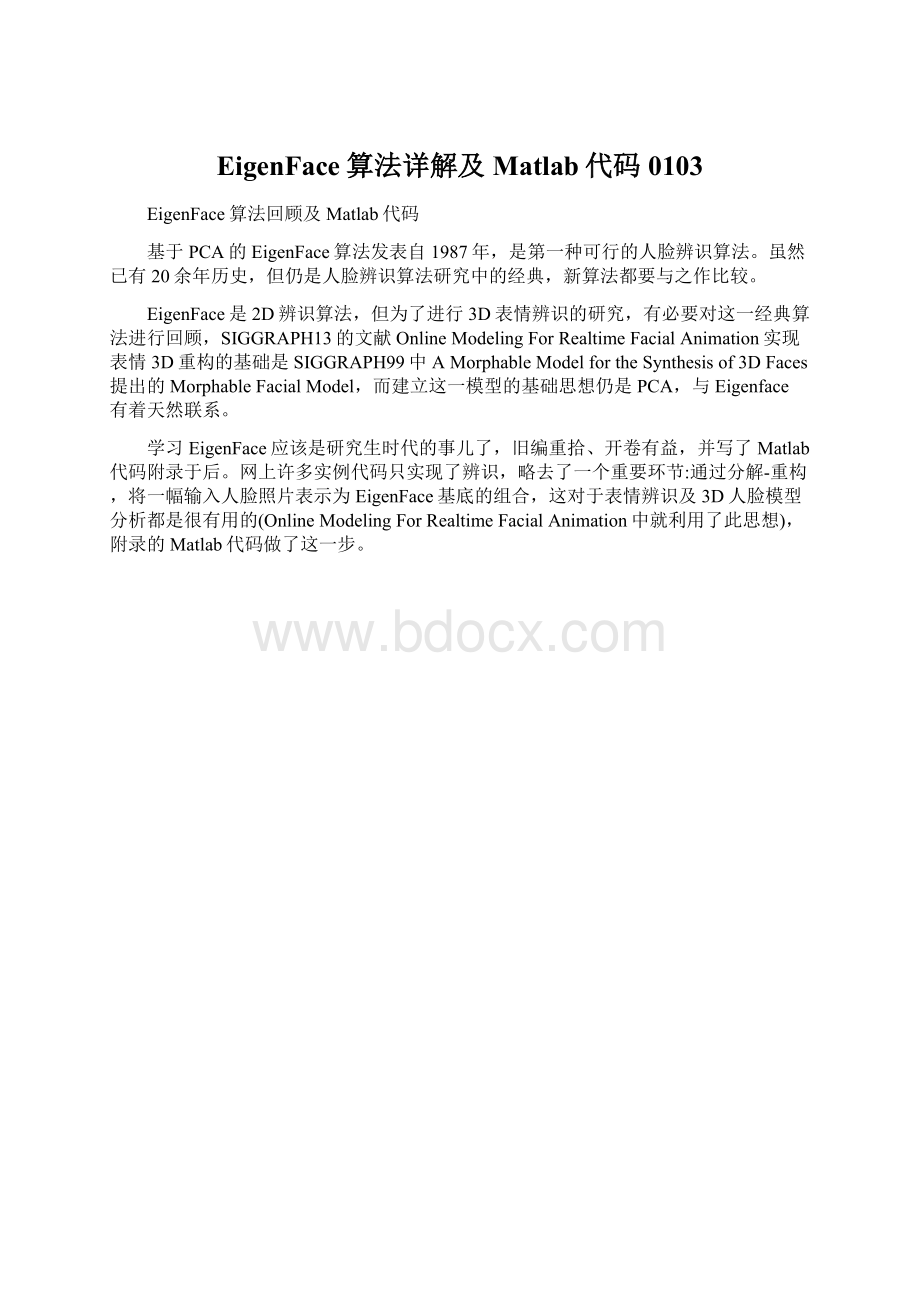EigenFace算法详解及Matlab代码0103.docx
《EigenFace算法详解及Matlab代码0103.docx》由会员分享,可在线阅读,更多相关《EigenFace算法详解及Matlab代码0103.docx(19页珍藏版)》请在冰豆网上搜索。

EigenFace算法详解及Matlab代码0103
EigenFace算法回顾及Matlab代码
基于PCA的EigenFace算法发表自1987年,是第一种可行的人脸辨识算法。
虽然已有20余年历史,但仍是人脸辨识算法研究中的经典,新算法都要与之作比较。
EigenFace是2D辨识算法,但为了进行3D表情辨识的研究,有必要对这一经典算法进行回顾,SIGGRAPH13的文献Online Modeling For Realtime Facial Animation实现表情3D重构的基础是SIGGRAPH99中A Morphable Model for the Synthesis of 3D Faces提出的Morphable Facial Model,而建立这一模型的基础思想仍是PCA,与Eigenface有着天然联系。
学习EigenFace应该是研究生时代的事儿了,旧编重拾、开卷有益,并写了Matlab代码附录于后。
网上许多实例代码只实现了辨识,略去了一个重要环节:
通过分解-重构,将一幅输入人脸照片表示为EigenFace基底的组合,这对于表情辨识及3D人脸模型分析都是很有用的(Online Modeling For Realtime Facial Animation中就利用了此思想),附录的Matlab代码做了这一步。
训练集合包含20幅图片
生成20-1=19个特征脸
最近欧式距离法得出的前三位匹配
利用特征脸空间进行人脸重构
http:
//www.pages.drexel.edu/~sis26/Eigenface Tutorial.htm中给出了EigenFace算法Matlab 代码,含有重构过程与比较,但其代码中有一个错误,训练集合照片未减去平均脸,就计算协方差矩阵了
具体算法文献教材上都有,捡要点写几句:
(1) 将训练集合中的每幅图像拉伸为列向量,并减去所有图像的均值(称之为平均脸),形成N*M矩阵A,其中N为单幅图像像素数,M为图像数目(训练集合容量)。
(2) 求协方差矩阵AA'的特征向量,作为正交基底张成人脸空间,好是好但运算量过大,转而求替代矩阵(surrogate)A'A的特征向量,减少计算量
(3) 矩阵A'A的秩等于M-1,这是由于减去平均脸所致,故有M-1个非零特征值(正),去除属于0的特征向量,将M-1个属于非零特征值得特征向量(记住须作左乘A的修正)作为EigenFace基底(特征脸),张成人脸空间。
(4) EigenFace基底由M-1个相互正交的向量构成,它们是协方差矩阵AA'的前M-1个最显著的特征向量方向,能量主要集中在这些向量方向上,但要记住虽正交但不完备,故存在重构误差。
(5) 为了用EigenFace基底对人脸照片进行正确的分解-重构,需要对所得的基底向量进行规一化修正,因为A'A的特征向量左乘A之后,虽成为AA'的特征向量,但模不为1,需除以自身的模,修正为标准正交向量集合,才能进行投影分解-重构。
(6) 训练集合及测试集合中的人脸照片都能利用EigenFace基底较好地实现分解-重构,但训练集合之外的人脸,重构误差变大
(7) EigenFace缺点:
1拍摄时光照环境对识别效果(EigenFace基底)影响大
2训练集合扩容时,需重构EigenFace基底
(8) 为了有效显示EigenFace基底图像(特征脸)需要用imagesc函数
Eigenface算法识别人脸的步骤:
Thissectiongivesstep-by-stepinstructionsalongwithphotosandformulasonhowtorecognizefacesandimplementedintoMatlab.Allthenecessaryfilestocompletethistutorialwouldbeprovided.
Steps
1.ThefirststepistoobtainasetSwithMfaceimages.InourexampleM=25asshownatthebeginningofthetutorial.EachimageistransformedintoavectorofsizeNandplacedintotheset.
2.Afteryouhaveobtainedyourset,youwillobtainthemeanimageΨ
3.ThenyouwillfindthedifferenceΦbetweentheinputimageandthemeanimage
4.NextweseekasetofMorthonormalvectors,un,whichbestdescribesthedistributionofthedata.Thekthvector,uk,ischosensuchthat
求特征值:
isamaximum,subjectto
Note:
ukandλkaretheeigenvectorsandeigenvaluesofthecovariancematrixC
5.WeobtainthecovariancematrixCinthefollowingmanner
Wherethematrix
.ThematrixC,however,isN2byN2,anddeterminingtheN2eigenvectorsandeigenvaluesisanintractabletaskfortypicalimagesizes.Weneedacomputationallyfeasiblemethodtofindtheseeigenvectors.
WecansolvefortheN2dimensionaleigenvectorsinthiscasebyfirstsolvingfortheeigenvectorsofanMbyMmatrix-e.g.,solvinga16*16matrixratherthana16,384*16,384matrixandthentakingappropriatelinearcombinationsofthefaceimagesΦi,ConsidertheeigenvectorsviofATAsuchthat
ATAvi=μivi
PremultiplyingbothsidesbyA,wehave
AATAvi=μiAvi
FromwhichweseethatAvi(特征向量)aretheeigenvectorsofC=AAT.
Followingthisanalysis,weconstructtheMbyMmatrixL=ATA,where
(Φ是1*16,384维的向量),andfindtheMeigenvectors,vi(M维的向量)ofL.ThesevectorsdeterminelinearcombinationsoftheMtrainingsetfaceimagestoformtheeigenfacesul(特征脸向量).Oncewehavefoundtheeigenvectors,vl,ul
l=1,2,…M
6.Thesearetheeigenfacesofoursetoforiginalimages
RecognitionProcedure
1.Anewfaceistransformedintoitseigenfacecomponents.FirstwecompareourinputimagewithourmeanimageandmultiplytheirdifferencewitheacheigenvectoroftheLmatrix.EachvaluewouldrepresentaweightandwouldbesavedonavectorΩ.
新脸向量在每个特征脸向量上的投影:
Fork=1,2,…,M’.
2.Wenowdeterminewhichfaceclassprovidesthebestdescriptionfortheinputimage.ThisisdonebyminimizingtheEuclideandistance
3.Theinputfaceisconsidertobelongtoaclassifεkisbellowanestablishedthresholdθε.Thenthefaceimageisconsideredtobeaknownface.Ifthedifferenceisabovethegiventhreshold,butbellowasecondthreshold,theimagecanbedeterminedasaunknownface.Iftheinputimageisabovethesetwothresholds,theimageisdeterminedNOTtobeaface.
4.Iftheimageisfoundtobeanunknownface,youcoulddecidewhetherornotyouwanttoaddtheimagetoyourtrainingsetforfuturerecognitions.Youwouldhavetorepeatsteps1trough7toincorporatethisnewfaceimage.
ThesourcecodefacerecognitionusingMatlabisprovidedbelow:
Matlab代码:
所用训练集合含20幅jpg图片,存于名为TrainDataBase的文件夹中,测试集合含10幅jpg图片,存于名为TestDataBase的文件夹中,命名均为1.jpg 2.jpg 3.jpg........
%----------------------------------------------------------------------
%人脸辨识:
FaceRecognition
%EigenFace算法
%EigenFace空间的生成分解与合成
%人脸辨识
%-----------------------------------------------------------------------
functionmeigenface()
%------------------------------------------------------
%step1:
读取训练集合中的人脸照片,并通过列向量拉伸生成
%人脸训练集合矩阵
%------------------------------------------------------
clearall
clc
closeall
imset=[];
M=20;%训练集合中人脸照片的数目
figure
(1);
fori=1:
M
filename=['.\TrainDataBase\'num2str(i)'.jpg'];
im=imread(filename,'JPG');
im=im(:
:
2);
%im=im(:
:
3);
[imheightimwidth]=size(im);
%将图像矩阵按列拉伸为列向量
imv=reshape(im,imheight*imwidth,1);%将im中数据转化为imheight*imwidth高的列向量
imset=[imsetimv];%将每个图像的像素占据一列位置,共20列向量
ifi==4
title('训练集合人脸照片','fontsize',18)
end
subplot(5,4,i);
imshow(im);
end
disp('============Outputimageiscompleted!
===================')
%imset=double(imset);
imset=double(imset);
[w,h]=size(imset)
%------------------------------------------------------
%step2:
生成训练集合的平均脸
%------------------------------------------------------
averageface=mean(imset,2);
%imset每行的平均值,由于imset为单列向量,每行包含一个元素,因此此操作为将每行的所有值取平均值
figure
(2);
imshow(uint8(reshape(averageface,imheight,imwidth)));
title('平均脸');
%------------------------------------------------------
%step3:
将人脸训练集合修正为与平均人脸的差:
以便计算
%协方差矩阵Covariancematrix
%------------------------------------------------------
imset_d=imset;
figure(3);
fori=1:
20
imset_d(:
i)=imset(:
i)-averageface;
im=reshape(imset_d(:
i),imheight,imwidth);
ifi==4
title('与平均脸的差','fontsize',18)
end
%subplot(4,5,i);
subplot(5,4,i);
im=imagesc(im);colormap('gray');
%imshow(im);
end
%
%------------------------------------------------------
%step4:
生成EigenFace特征脸空间
%------------------------------------------------------
%互相关矩阵为A*A',为减少计算量,计算代理矩阵A'*A的特征值特征向量
A=double(imset_d);%includethedataoftwentyimages.%matrixof36000hightand20width
[Ah,Aw]=size(A)
L=A'*A;%matrixof20hightand20width
[Lh,Lw]=size(L)
[vd]=eig(L)%v为L的特征向量,d为L的特征值
dL=L*v-v*d
%人脸照片修正为与平均脸的差,此时矩阵A'*A的秩为M-1,特征值中含有一个0
%需要去除属于0的特征向量,Eigenface基底由M-1组正交向量组成
[vd]=EliminateZero(v,d)%去除属于0的特征向量,同时将特征向量按特征值大小降序排列
%生成人脸空间矩阵:
eigenface
eigenface=[];
fori=1:
M-1
mv=A*v(:
i);%左乘矩阵A,从而修正为协方差矩阵AA'的特征向量
%对Eigenface向量进行规一化修正,使每个Eigenface向量模为1,便于进行分解与合成
%是否进行此归一化修正对识别没有影响,但对利用Eigenface作为基底对人脸照片进行
%分解与重构却是必要的
mv=mv/norm(mv);%
eigenface=[eigenfacemv];%特征人脸空间
[eh,ew]=size(eigenface)
end
%显示归一化之后的人脸空间eigenface
figure(4);
fori=1:
M-1
im=eigenface(:
i);
im=reshape(im,imheight,imwidth);
ifi==4
title('特征脸空间:
EigenFace','fontsize',18)
end
subplot(5,4,i);
im=imagesc(im);colormap('gray');
%im=histeq(im,255);imshow(im);
end
%------------------------------------------------------
%step5:
计算训练集合中的照片在EigenFace基底上的投影坐标
%以便进行人脸辨识
%注:
如果用Eigenface基底直接对训练集合中的照片进行分解-重构
%则重构误差趋于0(1e-10),如果对测试集合中的人脸(同一人,但表情姿态略有出入)
%进行重构,则可观察到重构误差,这是由于EigenFace基底虽正交但不完备
%------------------------------------------------------
TrainCoeff=[];
fori=1:
M
%计算训练集合中第i幅图像在EigenFace基底上的投影
disp('The%dthfaceimage')
i=i
c=double(imset_d(:
i)')*eigenface;
TrainCoeff=[TrainCoeffc']
end
%------------------------------------------------------
%step6:
人脸辨识,采用最近欧式距离法
%计算输入图像在EigenFace基底上的投影坐标
%与训练集合中各图像的投影坐标进行比较,选取欧式距离最小者作为匹配项
%------------------------------------------------------
%读入测试集合人脸照片
N=10;%测试集合人脸照片数目
figure(5);
testset=[];
fori=1:
N
filename=['.\TestDataBase\'num2str(i)'.jpg'];
im=imread(filename,'JPG');
im=im(:
:
2);
[imheightimwidth]=size(im);
%将图像矩阵按列拉伸为列向量
imv=reshape(im,imheight*imwidth,1);
testset=[testsetimv];
%
subplot(3,4,i);
imshow(im);title(int2str(i));
end
text(200,15,'请选择一幅照片(1-10)','fontsize',18);
testset=double(testset);
n=input('请选择一幅照片(1-10):
');
%选取训练集合中第n幅人脸照片作为输入进行分解
InputImage=testset(:
n)-averageface;
%计算输入照片在EigenFace基底上的投影坐标向量
coeff=InputImage'*eigenface;
%计算与训练集合中各图像的投影坐标向量的欧式距离
cdist=[];
fori=1:
M
dist=(norm(coeff'-TrainCoeff(:
i)))^2;
cdist=[cdistdist];
end
[dindex]=sort(cdist)
inum=[index
(1),index
(2),index(3)];
figure(6);
subplot(2,3,2);
InputImage=reshape(InputImage+averageface,imheight,imwidth);
imshow(uint8(InputImage));title('输入照片');
subplot(2,3,4);
im1=imset(:
index
(1));
im1=reshape(im1,imheight,imwidth);
imshow(uint8(im1));title('匹配照片1');
subplot(2,3,5);
im2=imset(:
index
(2));
im2=reshape(im2,imheight,imwidth);
imshow(uint8(im2));title('匹配照片2');
subplot(2,3,6);
im2=imset(:
index(3));
im2=reshape(im2,imheight,imwidth);
imshow(uint8(im2));title('匹配照片3');
pause;close;
%------------------------------------------------------
%step6:
利用EigenFace基底对测试集合中的人脸照片进行
%分解-合成(重构)
%注:
如果用Eigenface基底直接对训练集合中的照片进行分解-重构
%则重构误差趋于0(1e-10),如果对测试集合中的人脸(同一人,但表情姿态略有出入)
%进行重构,则可观察到重构误差,这是由于EigenFace基底虽正交但不完备
%------------------------------------------------------
;%选取训练集合中第n幅人脸照片作为输入进行分解
InputImage=testset(:
n)-averageface;
%计算输入照片在EigenFace基底上的投影坐标
coeff=InputImage'*eigenface;
%在EigenFace基底上进行图像重构
ReconstructedImage=eigenface(:
1:
M-1)*coeff';
%计算重构误差
diff=ReconstructedImage-InputImage;
norm(diff),
InputImage=reshape(Inpu